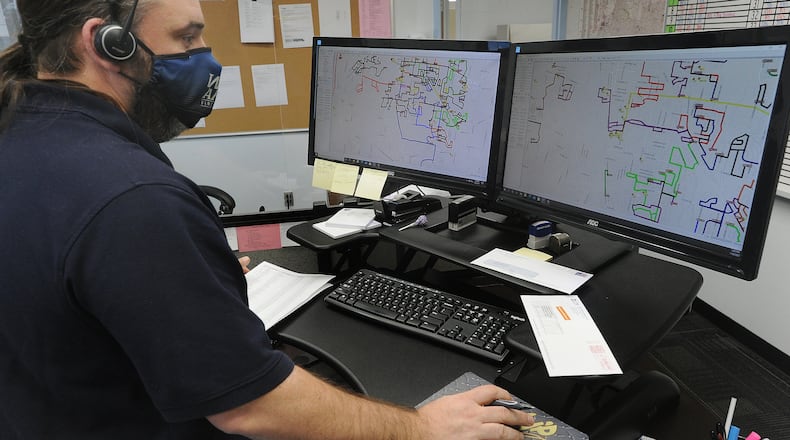“We go back and look at (bus driver) applicants; when Amazon opened here, our applicant flow decreased by about two-thirds,” Kettering Schools transportation director Todd Silverthorn said, referring to Amazon’s “last-mile delivery center” on Wilmington Pike. “COVID has lot to do with it too. (At Amazon) you can deliver packages. Here you’re having contact with human beings who could have the COVID virus.”
Most Kettering students are on remote learning until next Monday, but the district is still driving hundreds of students to school daily — special needs students and young “learning pod” students whose families don’t have child care availability.
Silverthorn said Kettering only has four substitute drivers available, but had six drivers out this week on COVID quarantine, plus the normal illnesses, meaning he had to cancel five routes on Tuesday.
“That’s a huge challenge — it inconveniences parents who rely on us for transportation to school,” he said. “And I canceled three special needs routes. Any type of change for those students is not good.”
Many school districts had students do classes remotely for the first week or two after Christmas break. But the majority locally are now back to some form of in-person school — either five days a week, or a hybrid where students are in-person 2-4 days and online 1-3 days.
Bellbrook schools currently have only two substitute drivers to cover for anyone who is sick or has to quarantine, according to retiring transportation director Beverly Wetzel. She said she and her soon-to-be-replacement Jacob Wilhite have both dropped what they were doing at times this school year to drive buses when there was no other option.
“We’re telling parents to be patient, that we’re coming,” Wetzel said. “Some days we might be a little later.”
Like many districts, Bellbrook has bounced back and forth between hybrid and fully in-person models. Wetzel said there are pros and cons each way. Hybrid schedules mean only half as many students are riding the bus on any given day, making social distancing possible. But the hybrids also make schedules confusing, as different students get picked up on different days.
“Being a sub is the hardest job,” Wilhite said. “Every day you’re hopping on a different bus, grabbing a different route sheet, and seeing different kids that you’re not familiar with.”
Fairborn schools struggled with multiple staffing issues in the fall, and did not offer busing in November due to driver quarantine issues. Amy Gayheart, Fairborn’s director of classified personnel, said the district required parents to sign up if their kids would ride buses during the second semester and they only routed those students, rather than planning busing for all.
“We are still short overall on drivers, but we are hopeful that this will alleviate most of those issues,” Gayheart said. “We intend to provide transportation to all students who request it.”
Troy schools moved grades 6-12 to remote learning for awhile in the fall because of COVID-related driver shortages. Superintendent Chris Piper said they’re now back to in-person classes and able to transport all the kids who qualify.
Troy, like Kettering and some other schools, has asked parents to drive their children to school if they’re able, as that helps the district serve those who need it most.
“We are thin on bus subs even when we are not in the midst of a global pandemic,” Piper said. “We are constantly looking for subs and would encourage certified drivers to apply for sub positions.”
Wetzel said school bus driving can be a good job for retirees or moms who have stayed at home when their kids were younger. But she acknowledged hiring has been tough despite recent pay increases, as it’s generally a part-time job and requires significant training to get the needed license.
Asked what else schools can do, Silverthorn called that the “million-dollar question” that’s discussed at conferences but not solved. Kettering is signing subs as contracted drivers and raising their pay, but they’re still short. He said parents will get automated calls in the morning if their child’s bus route is canceled.
About the Author



